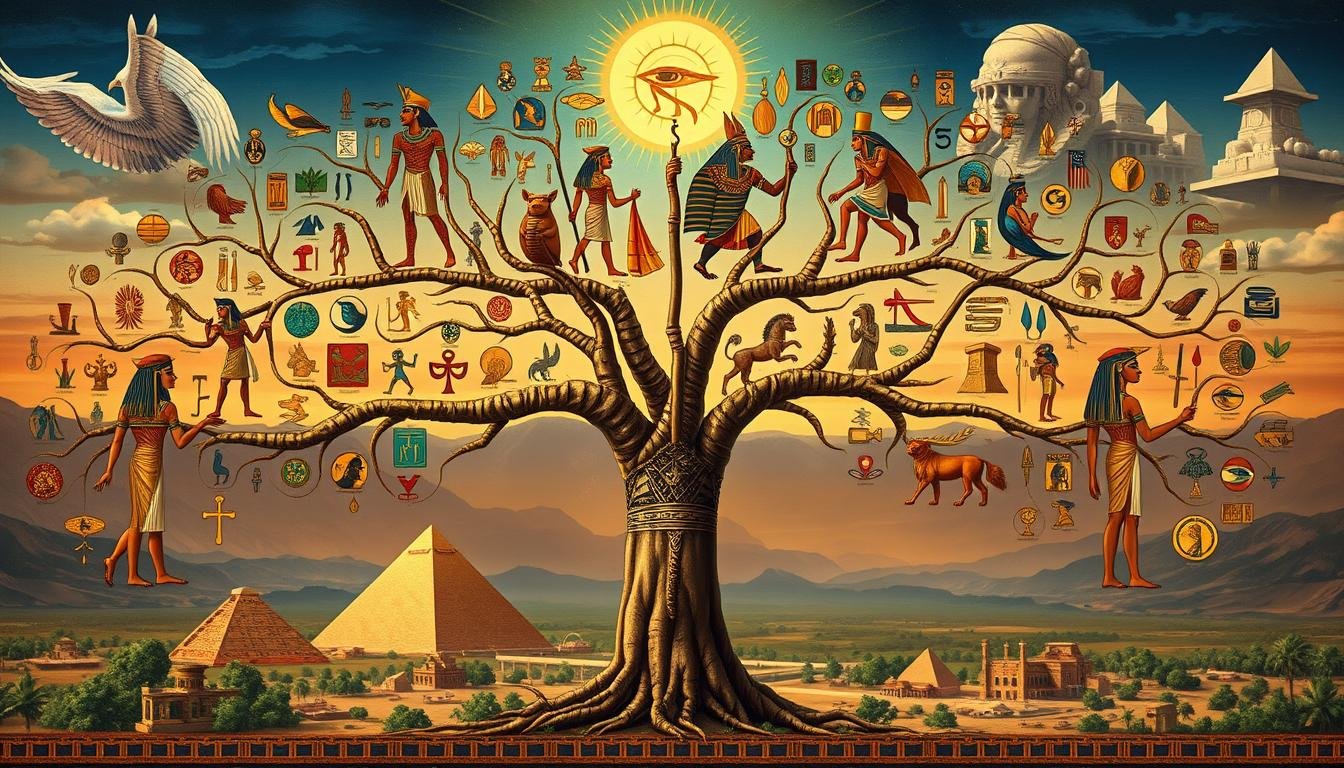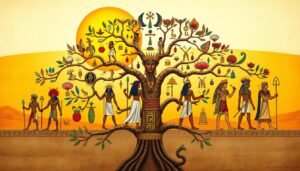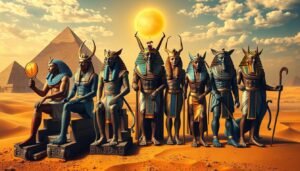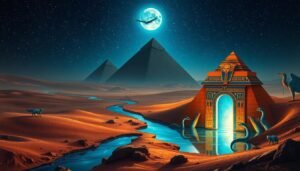The ancient Egyptians had over 2,000 gods. Each had their own role and family ties. This shows us the rich world of ancient Egyptian myths.
At the top were Shu, Tefnut, Geb, and Nut. Then there was the Osirian family: Osiris, Isis, Seth, and Nephthys. Their stories are full of wonder and have fascinated many for years.
Looking at the family tree of Egyptian gods, we see how deep and complex their beliefs were. These beliefs were a big part of their lives.
Install This 5000 Year Old ‘Egyptian Frequency’ In Your Brain To Manifest Money Effortlessly Like The Top 0.1% In 2024
Key Takeaways
- The ancient Egyptian pantheon was vast, comprising over 2,000 deities
- The family tree of Egyptian gods reveals the complex relationships and hierarchy among these divine entities
- Exploring the origins and genealogy of Egyptian deities provides insight into the cultural and spiritual beliefs of ancient Egypt
- The Osirian cycle and the cosmic quartet are two key examples of the interconnected nature of the Egyptian pantheon
- Understanding the lineage and hierarchy of Egyptian gods is essential for understanding the depth and complexity of ancient Egyptian mythology
Unraveling the Family Tree of Egyptian Gods
The ancient Egyptian gods had complex family ties. These ties formed the rich tapestry of Egyptian mythology. At the center were the Cosmic Quartet and the Osirian Cycle, key to the Egyptian belief system.
The Cosmic Quartet: Shu, Tefnut, Geb, and Nut
The Cosmic Quartet includes Shu, the sky god, and Tefnut, the goddess of moisture. Geb, the earth god, and Nut, the sky goddess, complete the group. They came from chaos, supporting the Egyptian world order.
The Osirian Cycle: Osiris, Isis, Seth, and Nephthys
The Osirian Cycle is a famous story in Egyptian mythology. It tells of Osiris, the god of the underworld, killed by Seth. Isis, the goddess of magic, brought Osiris back to life. Nephthys, the goddess of death, helped Isis in her quest.
These family tree of Egyptian gods stories shaped the origins of Egyptian gods. They also defined the Egyptian god family structures. These stories are key to understanding the lineage of Egyptian gods.
“The Egyptian gods were not simply deities, but rather embodiments of the natural forces that governed the universe.”
👉 Ancient Secrets To Unlock Your Manifestation Power
The family tree of Egyptian gods: A Hierarchical Lineage
The Egyptian pantheon was a complex tapestry of divine relationships. It had a clear hierarchy that showed who was in charge. The lineage of Egyptian gods showed how they were all connected, with family ties.
At the top were the pantheon of Egyptian gods. Gods like Ra, Atum, and Amun-Ra were the most respected. They were seen as the first gods, starting the Egyptian belief system.
- The Cosmic Quartet: Shu, Tefnut, Geb, and Nut, were the basic elements of the universe. They were at the heart of the Egyptian divine family.
- The Osirian Cycle included gods like Osiris, Isis, Seth, and Nephthys. They were key to stories of life, death, and rebirth.
- The relationships and power struggles between these gods were key to understanding the hierarchy of Egyptian gods.
The lineage of Egyptian gods was not just a list. It was a living, changing story of gods and their roles. The genealogy of Egyptian gods showed how gods could be many things, adding depth to the pantheon of Egyptian gods.
“The lineage of Egyptian gods was a reflection of the intricate web of cosmic forces that governed the ancient Egyptian worldview.”
The Nine Great Gods: Pillars of the Egyptian Pantheon
In the pantheon of Egyptian gods, a special group shines bright. They are the Nine Great Gods. These gods were at the heart of ancient Egyptian beliefs. They shaped the hierarchy of Egyptian gods and amazed people everywhere.
Ra: The Supreme Sun God
Ra, the sun god, was at the top. He was seen as the creator and the one who keeps life going. His power was like the sun’s, making him key in Egyptian mythology.
As the top god, Ra touched every part of ancient Egyptian life. This included religious rituals and leadership.
Anubis: Guardian of the Underworld
Anubis, the jackal-headed god, was also very important. He watched over the dead. Anubis helped souls find their way to the afterlife.
“The pantheon of Egyptian gods was a complex and interconnected system, with each deity serving a unique purpose and wielding immense power within the hierarchy of Egyptian gods.”
👉 The Surprising Way To Manifest More Money Now
The Nine Great Gods were the backbone of the Egyptian pantheon. Their impact lasted for centuries. By learning about these gods, we see the beauty of ancient Egyptian deities and their lasting legacy.
Exploring the Origins of Egyptian Deities
The ancient Egyptian pantheon was full of gods and goddesses. Each had its own story and importance. Learning about these Egyptian gods shows us the rich world of Egyptian mythology.
Many Egyptian deities came from nature. Ra, the sun god, brought life. Anubis, with his jackal head, watched over mummies and the afterlife.
The gods’ stories changed with Egypt’s history. As new areas and rulers came, their gods joined the Egyptian pantheon. This made the Egyptian gods and Egyptian mythology even more complex.
Some Egyptian deities were also influenced by other cultures. This included Mesopotamia and the Levant. This mix made the ancient Egyptian beliefs even more interesting.
By looking into the Egyptian gods‘ origins, we learn more about Egyptian mythology. We also understand the culture and beliefs of the ancient Egyptian people better.

“The Egyptian gods were not merely abstract concepts, but living beings that were deeply woven into the fabric of ancient Egyptian society.”
👉 The Surprising Way To Manifest More Money Now
The Genealogy of Egyptian Gods: Tracing Ancestral Roots
Exploring the Egyptian god family structures shows us amazing connections. These connections have shaped the gods’ world. The lineage of Egyptian gods is like a big family tree. It shows how gods came from other gods, making the pantheon of Egyptian gods rich and diverse.
Dynastic Deities: The Evolution of Divine Families
The genealogy of Egyptian gods centers on dynastic deities. These gods’ families were like the pharaohs’ families. This setup helped create the myths we love today.
Shu and Tefnut were the first gods. They had Geb and Nut, who were earth and sky. Then, each new generation added to the story. The Osirian cycle is a great example of this, with its tales of love and family.
| Deities | Relationship |
|---|---|
| Shu and Tefnut | Primordial parents |
| Geb and Nut | Children of Shu and Tefnut |
| Osiris, Isis, Seth, and Nephthys | Siblings, descendants of Geb and Nut |
The genealogy of Egyptian gods shows us how gods were connected. It also shows how their families changed over time. This story of gods and their families still fascinates us today.
The Hierarchy of Egyptian Gods: From Cosmic Forces to Local Patrons
In ancient Egypt, gods were organized in a special way. The strongest cosmic forces were at the top. Below them, patron gods looked after specific places or jobs. This showed how much the Egyptians respected their gods and saw the world as connected.
The top gods were the primordial forces like Atum, the creator, and Shu and Tefnut, the air and moisture pair. They were followed by the Osirian cycle with Osiris, Isis, and Seth. This group kept the cycle of life and death going.
As time went on, more gods appeared, each with their own area. Ra, the sun god, watched over the sky. Anubis took care of the dead. These gods worked together to keep the world and people safe.
The way the gods were organized showed the Egyptians’ view of the world. It also showed their society’s structure. Learning about the hierarchy of Egyptian gods helps us understand their beliefs and respect for their gods.

| Celestial Deities | Underworld Deities | Regional Patrons |
|---|---|---|
| Atum (creator god) | Osiris (ruler of the dead) | Anubis (guardian of the dead) |
| Shu and Tefnut (air and moisture) | Isis (goddess of magic and healing) | Ptah (patron of Memphis) |
| Ra (sun god) | Seth (god of chaos and destruction) | Sobek (crocodile god of the Nile) |
“The gods of ancient Egypt were not just powerful beings. They were the forces that shaped the universe and kept it balanced.”
The Lineage of Egyptian Gods: Interwoven Mythologies
The Egyptian gods’ stories are like a colorful tapestry. Each thread comes from different cultures. This shows how ancient worlds shared stories.
👉 You Don’t Deserve To Manifest Money
Influence of Near Eastern Civilizations
The gods of Egypt didn’t just come from Egypt. They were shaped by talks and trades with other places. This mix made their stories very rich and complex.
- The Osiris-Isis-Horus story is like the Sumerian Inanna-Dumuzi and Babylonian Ishtar-Tammuz tales. This shows they shared stories.
- Creation myths in Egypt are similar to Mesopotamia’s Enuma Elish and Babylon’s epic. They talk about the same big ideas.
- Anubis, the god of the afterlife, is like Mesopotamia’s Ereshkigal and Nergal. They all deal with the underworld.
These links show how cultures mixed and made the Egyptian gods’ stories special. They help us see the big picture of ancient Near Eastern myths.
Ancient Egyptian Deities: A Pantheon of Family Structures
The ancient Egyptian pantheon was full of divine family structures. These families had complex relationships and hierarchies. The gods were connected by family ties that shaped their myths.
At the center of this family tree were the nine great gods. Ra, the sun god, was the most important. Anubis, the god of the underworld, helped souls move to the afterlife. These gods worked together, showing the importance of family in Egyptian beliefs.
Looking into the family history of these gods shows how they came to be. Dynasties and Near Eastern cultures played a big role. The pantheon’s structure, from big cosmic forces to local gods, shows how family was key in ancient Egyptian life.
Install This 5000 Year Old ‘Egyptian Frequency’ In Your Brain To Manifest Money Effortlessly Like The Top 0.1% In 2024
FAQ
What is the family tree of the Egyptian gods?
The Egyptian gods’ family tree is very complex. It has a core group called the Cosmic Quartet and the Osirian Cycle. These groups are key to Egyptian myths and the universe.
What is the hierarchy of the Egyptian gods?
The Egyptian gods have a big hierarchy. At the top are the cosmic forces. Below are the gods of places and things.
The Nine Great Gods, like Ra and Anubis, are very powerful. They control the ancient Egyptian world.
What are the origins of the Egyptian gods?
The Egyptian gods started in many ways. They came from different times and places. Near Eastern cultures also helped shape them.
How are the Egyptian gods connected through their lineage?
The gods are linked by family ties. The Cosmic Quartet and the Osirian Cycle show these bonds. Each god is important in Egyptian stories.
What is the significance of the Egyptian god family structures?
Family was very important in ancient Egypt. The gods’ families showed this. They helped explain power and stories in Egypt.





